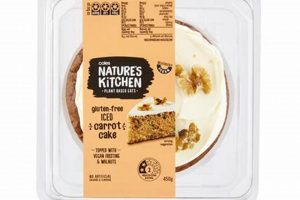This dish presents a plant-based alternative to traditional seafood preparations. It typically involves using the inner core of certain palm trees as a primary ingredient, mimicking the texture often associated with crab meat. These cakes are generally crafted by combining the core vegetable with binders, seasonings, and other vegetables, before being formed into patties and cooked through baking, pan-frying, or air-frying. They offer a dietary choice suitable for individuals following vegan or vegetarian lifestyles, or those with shellfish allergies.
The creation of such a recipe addresses the increasing demand for sustainable and ethical food options. Using plant-based ingredients can potentially reduce the environmental impact associated with fishing practices. Furthermore, these offer a healthier alternative due to often lower saturated fat content and the absence of cholesterol found in crustacean-based products. The historical context involves the rise of veganism and the search for creative substitutions for animal-derived foods.
Subsequent sections will elaborate on specific recipes, nutritional profiles, cooking techniques, and potential variations. Further discussion will explore the sourcing and sustainability considerations of the core ingredient. Finally, sensory evaluations and comparative analyses with conventional recipes will be presented.
Preparation and Serving Suggestions
Optimizing the creation and enjoyment of this dish requires careful attention to ingredient selection, cooking methods, and presentation. These suggestions aim to enhance both the culinary experience and the nutritional benefits.
Tip 1: Ingredient Quality: Source high-quality hearts of palm, ensuring they are firm and not overly fibrous. The texture of this ingredient significantly affects the final product’s mouthfeel and overall appeal.
Tip 2: Moisture Control: Thoroughly drain and, if necessary, pat dry the hearts of palm before processing. Excessive moisture can lead to soggy cakes that lack structural integrity.
Tip 3: Binder Selection: Experiment with different binding agents, such as ground flaxseed meal, breadcrumbs, or mashed potatoes, to achieve the desired consistency. The binder should provide sufficient cohesion without overpowering the primary flavor.
Tip 4: Seasoning Balance: Carefully balance the seasonings to complement the vegetable’s subtle flavor. Consider incorporating Old Bay seasoning, dill, lemon zest, or vegan Worcestershire sauce for added depth.
Tip 5: Cooking Technique: Employ a cooking method that promotes even browning and a crispy exterior. Pan-frying over medium heat or baking at a moderate temperature can yield optimal results.
Tip 6: Serving Suggestions: Serve these cakes with a complementary sauce, such as vegan tartar sauce, remoulade, or aioli. A fresh salad or steamed vegetables can provide a balanced accompaniment.
Tip 7: Texture Variation: For enhanced textural complexity, consider incorporating finely chopped vegetables such as red bell pepper, celery, or onion into the mixture. These additions can contribute both flavor and visual appeal.
These tips provide a foundation for culinary creativity and adaptation. By focusing on ingredient quality, technique, and flavor balance, the home cook can consistently produce an exceptional dish.
The article will now proceed to discuss the environmental impact of this recipe and potential substitutions for individuals with dietary restrictions or preferences.
1. Texture
Texture plays a fundamental role in the palatability and overall success of any culinary creation. In the context of these plant-based cakes, achieving a desirable texture is paramount to mimicking the sensory experience associated with traditional crustacean-based versions.
- Hearts of Palm Fiber Alignment
The inherent fibrous nature of the core ingredient dictates the initial texture. The manner in which the vegetable is processed whether shredded, chopped, or pureed directly influences the final product. Over-processing can result in a mushy consistency, while insufficient processing can lead to an overly stringy or tough mouthfeel.
- Binder Selection and Hydration
The choice of binding agent significantly impacts the internal structure and moisture retention. Ingredients like breadcrumbs, flaxseed meal, or mashed potatoes contribute to cohesion but also absorb moisture. Balancing the liquid content is crucial to prevent the cakes from being too dry or too wet. Proper hydration ensures a tender interior.
- Exterior Crust Formation
The development of a crisp outer layer provides textural contrast and enhances the overall eating experience. Factors such as cooking method (pan-frying, baking, or air-frying), surface oil, and the presence of starches in the batter or coating contribute to crust formation. Adequate heat transfer is essential for achieving a golden-brown and crispy exterior.
- Inclusion of Additional Vegetables
The incorporation of finely diced vegetables like bell peppers, celery, or onions introduces additional textural elements. These ingredients can contribute both crispness and moisture, depending on their preparation and quantity. Maintaining a balance between the core ingredient and these additions is important for achieving a harmonious textural profile.
The manipulation of texture is thus a critical element in the creation of these plant-based alternatives. Success depends on careful consideration of ingredient preparation, binder selection, cooking method, and the incorporation of complementary textural elements. By mastering these aspects, one can create a dish that closely replicates the sensory experience of traditional recipes while adhering to dietary restrictions and ethical considerations.
2. Flavor
The distinctive taste profile of “hearts of palm vegan crab cakes” is a result of carefully balancing the inherent mildness of the main ingredient with a deliberate selection of seasonings and complementary elements. Unlike traditional crab cakes, which derive their primary flavor from the crustacean itself, these plant-based versions require a nuanced approach to replicate the desired savory and umami characteristics. The core vegetable possesses a subtly sweet and slightly tangy flavor, necessitating the strategic addition of ingredients to mimic the briny and subtly sweet notes of seafood.
The development of a compelling flavor profile often involves incorporating elements traditionally associated with seafood preparations. For instance, Old Bay seasoning, a spice blend commonly used in crab boils, contributes a complex combination of savory, spicy, and slightly sweet notes. Seaweed flakes, such as nori or dulse, provide a subtle marine flavor, enhancing the perception of seafood. Lemon juice or zest adds brightness and acidity, balancing the richness of the other ingredients. Vegan Worcestershire sauce contributes depth and umami, replicating the savory notes found in conventional Worcestershire sauce. The specific combination and proportions of these ingredients are crucial in achieving a palatable and convincing flavor profile. In some cases, capers or finely diced pickles are added to provide a briny and tangy counterpoint, further enhancing the flavor complexity.
Ultimately, the success of “hearts of palm vegan crab cakes” hinges on the skillful manipulation of flavor. By strategically combining seasonings, spices, and umami-rich ingredients, it is possible to create a plant-based dish that captures the essence of traditional seafood preparations while adhering to dietary restrictions and ethical considerations. The final flavor profile should be balanced, complex, and evocative of the flavors associated with crab, creating a satisfying and convincing alternative for those seeking a plant-based option.
3. Sustainability
Sustainability, in the context of these plant-based cakes, centers on the responsible sourcing and environmental impact associated with the primary ingredient and other components of the recipe. The ecological footprint of food production is a growing concern, and the selection of this food should be made with awareness of these factors.
- Harvesting Practices Impact
The sustainability of hearts of palm hinges on harvesting methods. Unsustainable practices, such as clear-cutting entire palm groves, can lead to deforestation and habitat loss. Sustainable harvesting involves selectively removing stems from multi-stemmed palm species, allowing the plant to regenerate. Certified sustainable sources are crucial for ensuring responsible harvesting.
- Transportation Emissions
The distance traveled from the source to the consumer contributes to the overall carbon footprint. Importing from distant regions results in higher transportation emissions compared to locally sourced options. Consideration should be given to supporting local or regional suppliers to minimize environmental impact.
- Ingredient Sourcing Diversity
The sourcing of other ingredients, such as binding agents (breadcrumbs, flaxseed) and seasonings, also contributes to the overall sustainability. Utilizing locally grown and sustainably produced ingredients minimizes the environmental impact associated with transportation and agricultural practices. Prioritizing suppliers with eco-friendly practices is essential.
- Packaging and Waste Reduction
Minimizing packaging waste is a key component of sustainability. Selecting ingredients with minimal packaging or opting for bulk purchases can reduce waste generation. Composting food scraps and recycling packaging materials further contribute to a reduced environmental footprint.
The cumulative effect of these considerations determines the overall sustainability of this recipe. By prioritizing sustainably harvested ingredients, minimizing transportation distances, and reducing waste, the environmental impact can be significantly lessened. Consumers are encouraged to actively seek out responsibly sourced ingredients to promote a more sustainable food system.
4. Nutrition
The nutritional profile of these vegan cakes warrants careful consideration, particularly when comparing them to traditional crustacean-based counterparts. Hearts of palm, the primary ingredient, offers certain nutritional benefits but also presents limitations. It is relatively low in calories and provides a moderate source of dietary fiber, which can contribute to satiety and digestive health. Hearts of palm also contains essential minerals such as potassium, which plays a role in maintaining healthy blood pressure. However, it is not a significant source of protein or essential fats, nutrients abundant in crab meat.
The addition of other ingredients to the recipe, such as binders, vegetables, and seasonings, further influences the nutritional composition. The type of binder used can affect the carbohydrate and fiber content. For example, breadcrumbs will contribute more carbohydrates compared to flaxseed meal, which is a source of fiber and omega-3 fatty acids. The inclusion of vegetables such as bell peppers and onions adds vitamins and antioxidants. However, the method of cooking, particularly pan-frying with oil, can increase the fat content and caloric density of the final product. Therefore, baking or air-frying are often preferred methods for reducing fat intake. Furthermore, vegan crab cake recipes may vary substantially in their sodium content depending on the seasonings and ingredients used. Consumers with sodium restrictions should carefully review ingredient labels and adjust seasoning accordingly.
In summary, the nutritional value depends on the specific ingredients and cooking methods employed. While hearts of palm provides some fiber and minerals, the cakes generally require additional components to enhance their protein and healthy fat content. Careful attention to recipe selection and modification can result in a dish that offers a balanced nutritional profile suitable for individuals seeking a plant-based alternative to traditional crab cakes. Further research into optimizing the nutrient density of vegan crab cake recipes is warranted to ensure they can serve as a healthful and satisfying dietary option.
5. Technique
The successful creation of “hearts of palm vegan crab cakes” hinges significantly on mastering specific culinary techniques. The manipulation of ingredients, cooking methods, and presentation all contribute to the final product’s texture, flavor, and overall appeal. Improper technique can lead to undesirable outcomes such as a mushy texture, bland flavor, or structural instability. For example, failing to adequately drain the vegetable can result in a soggy cake that lacks the desired crispness. Conversely, over-processing can lead to a paste-like consistency, detracting from the intended texture. Therefore, understanding and applying appropriate techniques are crucial for achieving optimal results.
Proper binding is another critical aspect of technique. The choice of binding agent, such as flaxseed meal, breadcrumbs, or mashed potatoes, and its proper hydration are essential for holding the ingredients together. Insufficient binding can cause the cakes to fall apart during cooking, while excessive binding can result in a dense and unappetizing texture. The application of heat during cooking also requires careful attention. Pan-frying at an appropriate temperature ensures even browning and a crispy exterior without overcooking the interior. Baking or air-frying necessitate precise temperature and time control to achieve the desired texture and prevent dryness. Seasoning techniques also play a vital role in the final flavor profile. A balanced application of spices, herbs, and umami-rich ingredients is necessary to mimic the complex flavors of traditional recipes.
In conclusion, the creation of a palatable and appealing product relies heavily on the proper execution of culinary techniques. Mastering these techniques, from ingredient preparation to cooking methods, is essential for achieving the desired texture, flavor, and structural integrity. Continuous refinement of technique, through practice and experimentation, is crucial for consistent success in preparing this plant-based alternative.
6. Versatility
Versatility, in the context of hearts of palm vegan crab cakes, manifests in the adaptability of the recipe to accommodate diverse dietary needs, flavor preferences, and culinary applications. The fundamental structure of the recipe allows for substitutions and additions that cater to specific requirements, increasing its accessibility and appeal. This inherent adaptability is a crucial component of its success as a plant-based alternative. A base recipe can be modified to be gluten-free by substituting breadcrumbs with gluten-free alternatives like almond flour or rice crumbs. For individuals seeking to reduce sodium intake, low-sodium seasonings and fresh herbs can replace salt-heavy commercial spice blends.
The flavor profile can be tailored to specific tastes through the inclusion of various herbs, spices, and vegetables. A spicier variation might incorporate chili flakes or cayenne pepper, while a more savory version could feature smoked paprika or nutritional yeast. The cakes can be served in a variety of ways, extending their practical applications beyond a simple appetizer. They can be incorporated into salads, used as a filling for sandwiches or wraps, or served as a main course with a side of roasted vegetables. The ability to adapt the recipe to different culinary contexts enhances its overall value and utility. As an example, the cakes can be crumbled and used as a topping for pasta dishes or grain bowls, providing a plant-based source of protein and texture.
In conclusion, versatility is a defining characteristic of hearts of palm vegan crab cakes, contributing to their broad appeal and practicality. The ability to adapt the recipe to accommodate dietary restrictions, flavor preferences, and diverse culinary applications ensures its relevance and longevity. The challenge lies in maintaining the structural integrity and flavor balance of the cake while implementing modifications, requiring careful consideration of ingredient substitutions and adjustments to cooking techniques. This adaptability positions the recipe as a sustainable and inclusive option within the evolving landscape of plant-based cuisine.
7. Accessibility
The accessibility of hearts of palm vegan crab cakes is a multifaceted concept encompassing ingredient availability, affordability, ease of preparation, and inclusivity for individuals with diverse dietary needs. The extent to which these cakes are accessible significantly impacts their potential adoption as a sustainable and ethical alternative to traditional seafood preparations. Limited access to ingredients, high costs, complex preparation methods, or exclusion of specific dietary groups can impede their widespread consumption.
Ingredient availability is a primary determinant of accessibility. While hearts of palm are increasingly available in many supermarkets and specialty stores, they may be difficult to find in certain regions or for individuals with limited access to transportation. Affordability is another important consideration, as the cost of hearts of palm and other necessary ingredients can be a barrier for some consumers. Ease of preparation also affects accessibility, as complex recipes requiring specialized equipment or advanced culinary skills may be intimidating or impractical for many individuals. Finally, the recipe must be adaptable to accommodate various dietary restrictions, such as gluten intolerance, soy allergies, or nut sensitivities, to ensure inclusivity. For example, if a recipe relies heavily on soy-based ingredients, it is inaccessible to individuals with soy allergies, limiting its overall reach.
In conclusion, accessibility is a critical factor influencing the viability of hearts of palm vegan crab cakes as a mainstream dietary option. Addressing challenges related to ingredient availability, affordability, ease of preparation, and dietary inclusivity is essential for promoting their wider adoption. Future efforts should focus on streamlining recipes, sourcing affordable and readily available ingredients, and developing variations that cater to diverse dietary needs, ultimately enhancing their accessibility and solidifying their role as a sustainable and ethical food choice.
Frequently Asked Questions About Hearts of Palm Vegan Crab Cakes
This section addresses common inquiries regarding the preparation, nutritional value, and sustainability of this plant-based alternative to traditional crab cakes.
Question 1: Are hearts of palm vegan crab cakes nutritionally equivalent to traditional crab cakes?
While offering a plant-based alternative, this dish exhibits a different nutritional profile. Traditional crab cakes are a source of protein and omega-3 fatty acids. Hearts of palm provide fiber and certain minerals, but are lower in protein and lack significant omega-3s. Adjustments to the recipe can enhance its nutritional value.
Question 2: What is the best way to ensure the cakes do not fall apart during cooking?
Proper binding is essential. Adequate draining of hearts of palm reduces excess moisture. The use of a binding agent such as flaxseed meal, breadcrumbs, or a combination thereof is recommended. Refrigeration prior to cooking can also aid in solidifying the mixture.
Question 3: Can this recipe be adapted for individuals with gluten intolerance?
Yes, modifications can be made. Gluten-free breadcrumbs or alternative binding agents such as almond flour or rice flour can be substituted for traditional breadcrumbs. Careful attention to ingredient labels is crucial to ensure all components are gluten-free.
Question 4: How can the flavor of the cakes be enhanced to more closely resemble traditional crab cakes?
Enhancement of the flavor profile often involves strategic seasoning. The use of Old Bay seasoning, seaweed flakes, and vegan Worcestershire sauce can contribute to a more seafood-like flavor. Lemon juice or zest can add brightness and acidity.
Question 5: What are the sustainability considerations associated with hearts of palm?
Sustainability hinges on harvesting practices. Responsible harvesting involves selective removal of stems, allowing for plant regeneration. Sourcing from certified sustainable sources is recommended to minimize environmental impact.
Question 6: Are there alternatives to pan-frying that reduce the fat content of these cakes?
Yes, baking or air-frying offers a lower-fat alternative. These methods allow for cooking without the need for added oil. Adjustments to cooking time and temperature may be necessary to achieve optimal texture.
The answers provided offer insights into key aspects of preparing and consuming this plant-based dish. Careful consideration of these points can contribute to a more satisfying and sustainable culinary experience.
The subsequent section will offer variations of this recipe.
Hearts of Palm Vegan Crab Cakes
This exploration has illuminated various facets of hearts of palm vegan crab cakes, from their nutritional composition and culinary techniques to sustainability concerns and flavor profiles. The dish presents a plant-based alternative that addresses dietary restrictions and ethical considerations, while also requiring careful attention to texture, taste, and responsible sourcing.
The future trajectory of hearts of palm vegan crab cakes hinges on continued innovation in sustainable harvesting practices, recipe refinement to optimize nutritional value, and increased accessibility to diverse consumer groups. Further research and development are crucial to solidify their position as a viable and environmentally conscious culinary option.







